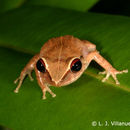Description
provided by AmphibiaWeb articles
The average SVL of E. antillensis is 30mm. E. antillensis is easily recognized from other Eleutherodactylus of Puerto Rico because the posterior side of the thighs has a black spottled pattern and the eyes are red. A fine line in the back may be present or absent. The color of the back is brown, varying in intensity although it is commonly a light brown (Rivero 1998) .The males usually call from leaves in protected parts of the plant.
- Ovaska, K., and Estrada, A.R. (2003). ''Eleutherodactylus antillensis (Coquí Churí). Reproduction.'' Herpetological Review, 34, 229.
- Rivero, J.A. (1998). Los Anfibios y Reptiles de Puerto Rico. University of Puerto Rico Press
- author
- Luis J. Villanueva-Rivera
Distribution and Habitat
provided by AmphibiaWeb articles
E. antillensis is native to Puerto Rico, the United States Virgin Islands and the British Virgin Islands. In Puerto Rico it occurs almost continuosly in the complete island, with the exception of the highest peaks. This species is common in urban areas, grasslands, and open forest areas, including dry forests (Rivero 1998; Schwartz and Henderson 1991).
- author
- Luis J. Villanueva-Rivera
Life History, Abundance, Activity, and Special Behaviors
provided by AmphibiaWeb articles
The species call from low vegation, usually hidden between leaves. It calls from dusk until dawn, but the activity decreases greatly after midnight (Rivero 1998). Egg clutches are laid in the ground, under a thin layer of leaf litter or soil. Number of eggs per clutch ranged from 24 to 42 and it is possible that the species has parental care (Ovaska and Estrada 2003) .
- author
- Luis J. Villanueva-Rivera
Life History, Abundance, Activity, and Special Behaviors
provided by AmphibiaWeb articles
No information is available. However, since it is very common in urban areas and pastures, it is probably stable. No threats have been identified.
- author
- Luis J. Villanueva-Rivera
Relation to Humans
provided by AmphibiaWeb articles
Since the call of this species is very similar to the common coquí (E. coqui), regarded as the national symbol of Puerto Rico, people tend to confuse it for E. coqui. In some urban areas it is the sole anuran present, so people confuse it with the common coquí.
- author
- Luis J. Villanueva-Rivera

